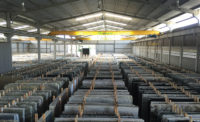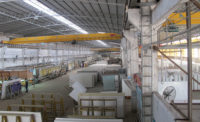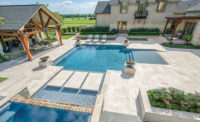In 1940, Eduarda and Eduardo Cosentino, parents of the current owners of Cosentino Group, started quarrying and carrying out basic marble processing in Macael, Almería, Spain. About 40 years later in 1979, the second generation of the family expanded the reach of its marble presence with the creation of Mármoles Cosentino, S.A. The company, an initiative of Francisco Martínez-Cosentino Justo and his brother Eduardo Martínez-Cosentino, began with only 17 workers. Several years later, the third brother, José Martínez-Cosentino, joined the company. They had one small warehouse in Barcelona, run by Eduardo, which stocked marble.
During the 1980s, Mármoles Cosentino S.A. expanded its business to other parts of Spain and Europe, including opening the company’s first retail outlets in France and Germany. However, the three brothers realized they couldn’t be limited to just extracting and processing the popular White Macael marble they were known for, so they decided to adopt a strategy of diversification and international expansion by investing in research and innovation. Thus, Cosentino embarked on an ambitious project that culminated in the construction of a revolutionary factory where Silestone was first manufactured in 1990. In just five years, this product became a huge success in the kitchen worktop sector, and has since become the company’s leading product, recognized worldwide as a renowned quartz brand, which just celebrated its 25th anniversary in 2015.
“In 1979, Cosentino was set up as a normal, average company,” said Jan Schuitemaker of the marketing department at the Cosentino Visitors Center, located within the Group’s industrial park and headquarters in Almería, Spain. “It had 50 employees at that time, and the company was just focused on marble. A lot changed later when Francisco Martínez-Cosentino became the president of the association of the stone masons in this area. That’s when they started to get more into sales and developing commercially abroad — in terms of exports — and making Macael a brand name in trade fairs and such.”
With a total surface area of more than one million square meters, the Cosentino Group industrial park is the production, administrative and logistical heart from where the Group controls and oversees its worldwide distribution system. “There are 1,200 people that work here, 300 of which work in the offices in the front of the site in the pyramid-shaped building, which we call the ‘Houses of Parliament,’” said Schuitemaker, who serves as the main tour guide for all visitors. “All of the different departments are there; there are 35 people in the marketing department, and the other departments which include purchasing, sales, IT, human resources, strategic planning and the legal department.”
In addition to the company’s headquarters, the industrial park houses all of the Cosentino’s main production centers, including the three factories that manufacture Silestone (one of the company’s most popular products), the marble factory, a modern facility manufacturing worktops, and a plant devoted to the production of special materials and the creation of millions of actual samples. The site is also home to a brand new factory that produces Dekton, the company’s most recent development: an ultra compact surface that’s created using a unique mixture of raw materials; and a one-of-a-kind, fully automated logistics platform.
Although the industrial park spans about one million square meters today, it wasn’t always that large, according to Schuitemaker, who described how much the site has transformed since it was first built. “Cosentino used to be located on a patch of land to the left and on the right was just land with almond trees and orange trees,” he explained. “Now, you can see that patch to the right is filled with containers; loads of those go to the U.S.”
The entry to the site, which used to be less than the size of a football field, was easily accessible when the site was first built, with no special security clearance that’s required to enter like there is today. “You could just drive up on the dust track to get to the main office of Cosentino, which you could see from the road at that time,” explained Schuitemaker. “That office was half the size that it is today with about 15 people working there. However, with the successes of Silestone, more and more people came to work here, which caused the company to double the size of that building. Then it was crammed with 80 people — some in the offices and some for the lines for polishing marble.”
Today, the park has a total of three Silestone factories, which have each grown over the years. The first factory, built in 1990, initially had one production line, but now incorporates three. The second factory, established in 2004, contains four production lines; while the third and most recent factory, which was built less than 10 years ago in 2007, includes four production lines for a total of 11 production lines. “One line produces about 300 slabs each day,” said Schuitemaker. “Having 11 production lines, it’s also very easy to change colors.
“We also have another factory where they produce all of the colors for the Silestone slabs,” added Schuitemaker. “There’s a laboratory located in there so we can be very creative with the colors and also where we can copy a color for a customer. For example, when a franchise business says they want to have a worktop in their own color, we can copy the color and make the slabs for them; we do that for different companies.”
For Silestone production, Cosentino utilizes about 35 trucks for raw materials each day, which are all thoroughly inspected, according to Schuitemaker. “Every truck has to pass quality control,” he explained. “They check every truck that comes in. They take samples of every truck and if they’re not happy with the quality, the truck will not unload in any of the three factories. If they’re not happy, it’s just not accepted. It does happen, but it’s very rare.”
The company distributes to more than 80 countries throughout the five continents, with international expansion serving as a strategic asset. In 2014, international business accounted for 90% of its sales; however, since the company’s expansion over 20 years ago, the U.S. has become its main market.
Today, Cosentino Group is a renowned global, Spanish, family-owned company that produces and distributes high-value innovative surfaces for the world of design and architecture. With seven production facilities, 12 natural stone quarries, 13 kitchen and bathroom surface production centers and more than 100 company centers located throughout the world, Cosentino Group is constantly “working towards long-term and lasting relationships with clients, which are the soul of the family business,” according to Schuitemaker.













